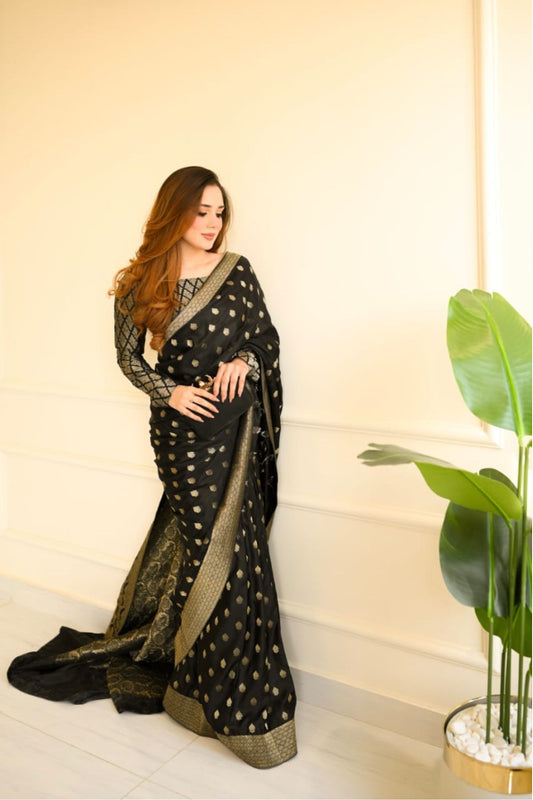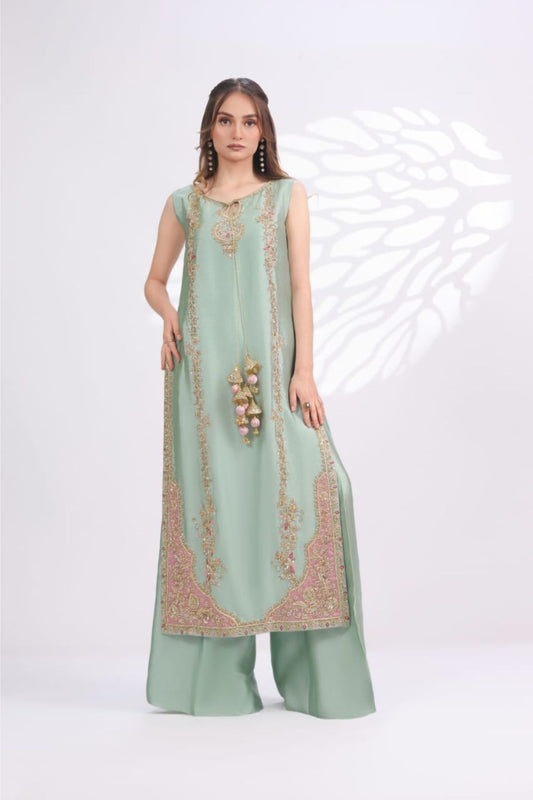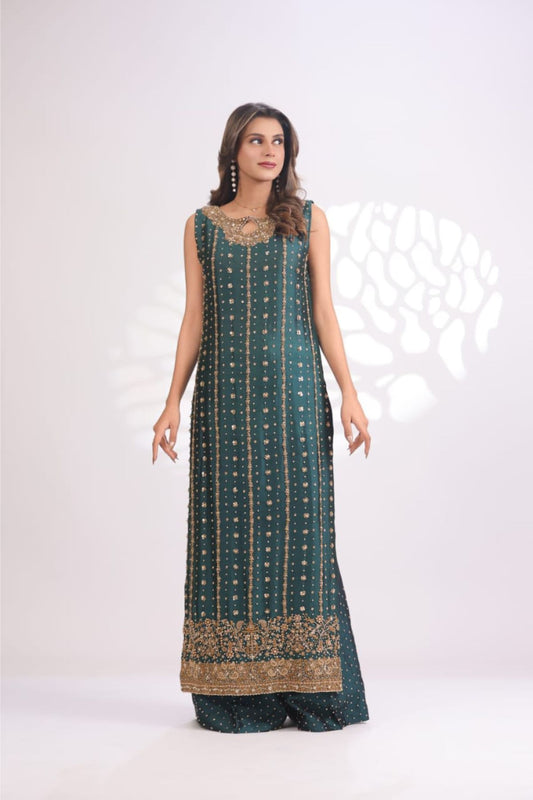Embroidery Artistry: Intricate Designs on Pakistani Sarees
Embroidery artistry in Pakistani sarees is a meticulous and time-honored craft that involves the use of various techniques to create intricate and stunning designs on the fabric. Pakistani sarees are celebrated for their rich cultural heritage, and embroidery plays a pivotal role in enhancing their beauty. Here's a breakdown of some key embroidery techniques featured in Pakistani sarees, along with highlights of specific regions known for their unique styles:
Threadwork
Threadwork embroidery is a meticulous and intricate craft that involves using various types of stitches to create detailed and captivating patterns on fabric. This delicate artistry is a hallmark of Pakistani sarees, adding a touch of elegance and sophistication to these traditional garments. Two popular techniques within threadwork embroidery in Pakistani sarees are Kamdani work and Resham embroidery.
Kamdani Work:
Kamdani work is a form of threadwork embroidery that imparts a luxurious and shimmering effect to the fabric. This technique involves the use of tiny, metallic threads, often gold or silver in color, which are meticulously stitched onto the fabric. The word "Kamdani" itself means "small work," emphasizing the intricate nature of this embroidery style. Artisans skillfully create small, dazzling patterns, resulting in a fabric that glimmers with every movement. Kamdani work is frequently employed to embellish borders, pallus, and the overall body of Pakistani sarees, adding a touch of opulence to the garment.
Resham Embroidery:
Resham embroidery, also known as silk thread embroidery, is another exquisite form of threadwork seen in Pakistani sarees. In this technique, colorful silk threads are used to create intricate patterns, designs, and motifs on the fabric. The term "Resham" itself refers to silk, highlighting the primary material used in this type of embroidery. Resham embroidery allows for a broad spectrum of vibrant hues, showcasing the artful use of color to enhance the beauty of the saree. The resulting patterns are often intricate and diverse, ranging from floral motifs to geometric designs, contributing to the overall richness of the fabric.
Zari Embroidery
Zari embroidery is a distinguished and opulent technique that embellishes Pakistani sarees with metallic threads, typically gold or silver in color. This exquisite form of embroidery imparts a regal and luxurious appearance to the fabric, making it a popular choice for celebratory occasions and formal events. Here's an exploration of the characteristics and significance of Zari embroidery in the context of Pakistani sarees:
Characteristics of Zari Embroidery:- Metallic Threads: Zari embroidery exclusively utilizes metallic threads, with gold and silver being the predominant choices. These threads are woven, braided, or coiled to create intricate patterns and designs on the fabric.
- Intricate Patterns: Zari embroidery is renowned for its intricate and detailed patterns. Artisans skillfully manipulate the metallic threads to form borders, motifs, and elaborate designs that contribute to the overall opulence of the saree.
- Versatility: Zari is versatile and can be used in various ways, from creating fine outlines and borders to covering larger areas of the fabric. The versatility of Zari embroidery allows for a wide range of design possibilities, adding to its appeal.
Regal and Opulent Look:
Zari embroidery is synonymous with a regal and opulent aesthetic. The use of gold and silver threads elevates the visual appeal of the saree, giving it a grand and majestic presence. The shimmering effect created by Zari adds a touch of glamour, making it a go-to choice for occasions that demand sophistication and extravagance.
Applications in Pakistani Sarees:
- Intricate Borders: Zari is often employed to create intricate borders along the edges of the saree. These borders may feature elaborate patterns, geometric designs, or floral motifs, contributing to the overall richness of the garment.
- Central Motifs: Zari is frequently used to highlight central motifs or focal points on the saree. These motifs can range from traditional symbols to contemporary designs, showcasing the adaptability of Zari embroidery.
- Pallus and Drapes: The drape and pallu of the saree provide ample space for showcasing the brilliance of Zari embroidery. Elaborate Zari work on these areas enhances the saree's visual impact and creates a sense of continuity in the design.
Associations with Celebratory Occasions:
Zari embroidery is often reserved for special occasions and celebratory events. Whether it's weddings, festivals, or formal gatherings, Zari-adorned Pakistani sarees are a symbol of elegance and grace. The regal look achieved through Zari embroidery makes it a fitting choice for moments of significance and festivity.
Mirror Work
Mirror work, also known as Shisha embroidery, is a captivating and distinctive feature of Pakistani sarees. This traditional technique involves the meticulous stitching of small pieces of mirrors onto the fabric, creating a reflective mosaic that adds a dynamic and visually striking element to the saree. Here's an exploration of the characteristics and significance of mirror work in the context of Pakistani sarees:
Characteristics of Mirror Work:- Intricate Stitching: Mirror work involves the precise stitching of small, reflective mirrors onto the fabric. Artisans skillfully secure each mirror in place using various stitches, creating patterns that enhance the overall design of the saree.
- Reflective Mosaic: The use of mirrors introduces a reflective quality to the saree. The mirrors catch and reflect light, adding a dynamic and shimmering effect to the fabric. This reflective quality contributes to the saree's allure, especially in well-lit environments.
- Enhanced Visual Appeal: The play of light on the mirrors creates a visually captivating effect. As the wearer moves, the mirrors catch and reflect light, adding a sense of dynamism to the saree. This element of movement enhances the overall visual appeal of the garment.
- Dynamic Patterns: Depending on the arrangement of mirrors and the chosen stitching patterns, mirror work can create dynamic and eye-catching designs. From geometric shapes to floral motifs, the reflective quality of mirrors adds depth and complexity to the overall aesthetic.
- Embellishing Borders: Mirror work is often used to embellish the borders of Pakistani sarees. The reflective mirrors add a touch of glamour and sophistication to the edges of the fabric, framing the saree beautifully.
- Pallus and Drapes: Mirrors are strategically placed on the pallu and drapes of the saree, allowing for an enhanced play of light. This placement ensures that the reflective quality is showcased prominently, creating a stunning effect as the saree is draped and worn.
- Body of the Saree: Mirror work is not limited to borders; it is frequently incorporated into the body of the saree itself. Intricate patterns, designs, and motifs featuring mirrors are carefully stitched, creating a cohesive and visually appealing overall look.
- Traditional and Timeless: Mirror work is considered a key design element in Pakistani sarees, contributing to their traditional and timeless appeal. The craftsmanship involved in mirror work has been passed down through generations, making it a cherished and enduring feature.
- Symbolism: Mirrors in Pakistani sarees are often symbolic, representing facets of culture, tradition, and spirituality. The reflective nature of mirrors may be associated with the idea of self-reflection or the belief in warding off evil spirits.
Specific regions in Pakistan are renowned for their unique contributions to the world of embroidery:
Lahore:
Lahore is celebrated for its Resham (silk) embroidery. This style often involves the use of silk threads to create lush and vibrant designs. The Resham embroidery of Lahore reflects the city's cultural richness and artistic finesse, making it a significant hub for embroidery craftsmanship.
Multan:
Multan is known for Aari and Karchobi embroidery. Aari involves the use of a hooked needle for fine, detailed work, while Karchobi includes metallic thread and wire embroidery. Both techniques result in intricate patterns that showcase the craftsmanship and attention to detail inherent in Multani embroidery.
Karachi:
As a cosmopolitan hub, Karachi brings a contemporary twist to Pakistani saree embroidery. Fusion embroidery techniques blend traditional styles with modern designs, catering to the evolving tastes of the urban, fashion-forward woman.
Peshawar:
Peshawar's embroidery styles are influenced by Pashtun culture. The embroidery often features geometric patterns, intricate needlework, and the use of vibrant colors, reflecting the rich cultural heritage of the region.
Quetta:
Quetta is renowned for its Balochi embroidery, characterized by nature-inspired motifs and cultural symbols. Balochi embroidery often tells stories through unique patterns and designs, making it a distinctive and cherished style.
In conclusion, the embroidery artistry found in Pakistani sarees is a testament to the country's diverse cultural influences and skilled craftsmanship. The use of threadwork, zari, and mirror work, combined with the regional variations in embroidery styles, makes Pakistani sarees a canvas of tradition, creativity, and unparalleled beauty. Each saree becomes a wearable piece of art, carrying the legacy of generations of artisans who have perfected the craft of embroidery in different corners of Pakistan.






